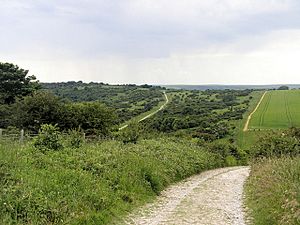Lullington Heath facts for kids
| Site of Special Scientific Interest | |
 |
|
| Area of Search | East Sussex |
|---|---|
| Interest | Biological |
| Area | 72.7 hectares (180 acres) |
| Notification | 1986 |
| Location map | Magic Map |
Lullington Heath is a special natural area in East Sussex, England. It covers about 72.7 hectares (180 acres) of land. This place is protected because it has unique plants and animals. It is known as a Site of Special Scientific Interest (SSSI) and a National Nature Reserve.
Discovering Lullington Heath
Lullington Heath is located west of Eastbourne. It became a protected site in 1986. Being a Site of Special Scientific Interest means it is important for its wildlife or geology. As a National Nature Reserve, it is one of the best places for nature in the country.
Unique Habitats
This special area has two very rare types of natural environments. These are called chalk heath and chalk grassland. Imagine a mix of open grassy fields and areas with small shrubs. All of these plants grow on chalky soil.
Plants and Animals
Long ago, most of Lullington Heath was covered in chalk heath. But in the 1950s, a disease called myxomatosis affected rabbits. There were far fewer rabbits to eat the plants. This allowed more scrub, which are small trees and bushes, to grow.
Today, the chalk grassland is full of beautiful flowering plants. The scrub and rough grassland areas are perfect homes. Many invertebrates, like insects, and different kinds of birds live here. This makes Lullington Heath a very important place for nature.

